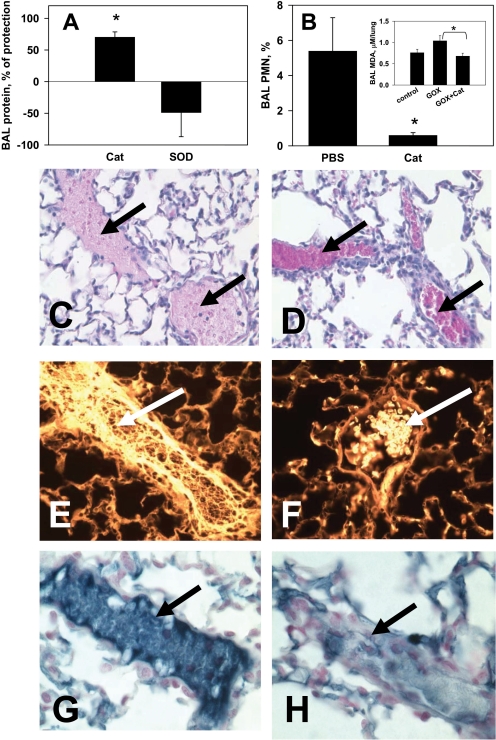Fig. 2.
Anti-PECAM/catalase, but not anti-PECAM/SOD, attenuates acute lung injury and thrombosis in a mouse model of “double-hit” oxidative stress caused by H2O2 production and hyperoxia (“GOX”). Mice received intravenous injections of equimolar doses of anti-PECAM/catalase or anti-PECAM/SOD or a mixture of both conjugates. Ten minutes later, 0.75 μg/g i.v. anti-TM/GOX was injected and mice were placed in 80% O2. Four hours later, mice were sacrificed, BALF obtained, and the lungs harvested and analyzed. A, degree of protection against lung edema tested by BALF protein level. B, attenuation of neutrophil alveolar transmigration and level of oxidative stress marker MDA in BALF (inset). *, P < 0.05 versus the corresponding control group. C and D, hematoxylin and eosin staining of lung tissue sections of GOX/hyperoxia challenged mice treated with saline (C) or anti-PECAM/catalase (D). Arrows in C show vessels with intravascular hemolysis and fibrin deposition (pink background), and arrows in D show congested vessels with intact red blood cells. E and F, autofluorescence of lung sections viewed via epifluorescence 4,6-diamidino-2-phenylindole/orange filter (380.0 nm/750.0 nm) show hemolyzed erythrocytes (arrow) in the vessels of PBS-treated mice challenged with GOX (E), and intact RBCs in anti-PECAM/catalase-treated mice challenged with GOX (F). G and H, anti-PECAM/catalase protects against pulmonary thrombosis caused by GOX/hyperoxia vascular oxidative stress. Blue color shows immunostaining for mouse fibrinogen. Cat, catalase; PMN, polymorphonuclear neutrophil.

